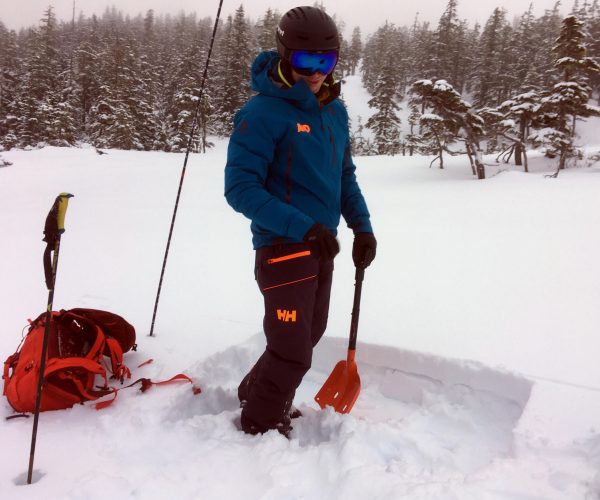
Already this winter, at least seven people have been reported caught in avalanches around Alaska. Of those, two people were killed near Haines just before New Year’s Eve.
What about avalanche conditions in the Juneau area right now?
“We’re just about down to the ground here,” said Ed Shanley after he takes a portable shovel out of his backpack and digs into the season’s snowpack just outside the ski boundaries at Eaglecrest Ski area.
A big rectangular pit starts taking shape. It’s almost 3 feet deep, with perfectly straight vertical sides.
Shanley said he doesn’t use this kind of test to justify doing something risky.
“You should always be kind of trying to find instability,” he said. “That’s kind of the mindset that I take.”
That’s why he may dig as many as ten snow pits each day.
Shanley is a part-time avalanche technician for a utility company. But his main winter gig is as a guide for a local heli-ski company. When he’s done digging and shoveling snow, he points out the different layers, like a geologist who uses a fossil record to determine the age of rock going back in time. Looking at each deeper snow layer tells a story about the winter.
He starts with the top 5 inches.
“You can see that there’s new snow we just got,” Shanley said. “There’s a little bit of a crust here, which is what I think was left over from the wind.”
Mid-January’s high winds and cold snap compacted the snow into an inch-and-a-half heavy, hard layer. Underneath that, a layer of coarse snow that comes apart very easily in Shanley’s hand.
“And it’s turning into this weak, faceted snow crystals,” Shanley said. “So, that’s not a very good set up. You don’t have a huge load on it or anything. If you had an avalanche, it’d be pretty shallow.”
That snow layer is the weakest. Below that, about two feet of December’s frozen rain and ice all the way down to the soil.

With a snow saw, Shanley cuts a long block along an edge of the pit. He gently sets the blade of the shovel flat on top and taps it with his finger.
Eventually, the top two layers of the block shear or shift a tiny fraction of an inch down and out. That’s the instability Shanley was looking for which could start an avalanche.
“If we were on a steeper location, that probably would’ve fallen into the pit,” he said.
At the time, Shanley said it wasn’t a great snowpack, not horrible either.
But after the past week’s weather with more snow, rain and higher temperatures? He said the avalanche hazard was trending higher. Still, warmer temperatures could also break down some of the layers and actually help long-term stability.
Come down out of the mountains and into downtown Juneau and “we were seeing some small avalanches around the region and wet, loose avalanches,” said City and Borough of Juneau avalanche forecaster Tom Mattice.
Mattice said there’s always more danger of an avalanche with additional snow and rain.
That weak layer still exists. But, so far, he said the snowpack is still fairly thin.

“The danger is not incredibly high right now in the backcountry,” Mattice said. “(But) in the areas down low – as you’re hiking along Perseverance Trail, as you’re hiking along the Flume Trail – there’s some concern. But it takes huge avalanches to get down to there.”
Shanley said avalanches are likely to start on any slope over 30 degrees, under a rounded outcropping called a convex rollover, or near a cornice.
And they’re most likely to happen right after high winds, big rainfall or a snowstorm, or during big changes in temperature.
Shanley said keep an eye out for warning signs like big cracks in the snow. And, listen for a hollow drum sound on hard snow.
Matt Miller is a reporter at KTOO in Juneau.




